Hello Visitor! Log In
Human Security: Concepts and Measurement
ARTICLE | February 28, 2023 | BY Phoebe Koundouri, Konstantinos Dellis
Author(s)
Phoebe Koundouri
Konstantinos Dellis
Abstract
The notion of Human Security has regained traction in the public domain, mostly following the disruptive impact of the global pandemic and the geopolitical tensions in Eastern Europe. The concept, however, was molded during the second half of the twentieth century, as scholars, policy makers and the public became ever more disillusioned with the focus on national security that dominated the public domain. The pressing issues of climate change, health challenges and human rights violations in the 21st century have resulted in elevated policy attention and resources for these issues in the form of targeted reports, concepts, metrics, empirical and theoretical research. Having said that, the introduction, monitoring and implementation of the SDGs within the UN 2030 Agenda are inherently related to the concept of Human Security and its components. This paper attempts to briefly present the various metrics and reports germane to Human Security. We undertake a general-to-specific approach to identify the measures, variables, and indicators, which are relevant to the concept of Human Security and its sub-categories. These variables and indicators derive from selected Indicators and Trends from UNHDR, Fragile States Index (FFP), Corruption Perception Index (Transparency International), Biodiversity Habitat Index and CO2 exposure (Environmental Performance Index), Ecological Threat Index (Institute for Economics and Peace) and Healthy Life Expectancy (WHO). Then, we conceptually map the indicators to the measurement and implementation of the Sustainable Development Goals (SDGs) using data available from the UN SDSN Sustainable Development Report.
1. Introduction
The notion of Human Security has regained traction in the public domain, mostly following the disruptive impact of the global pandemic and the geopolitical tensions in Eastern Europe. The concept, however, was molded during the second half of the twentieth century, as scholars, policy makers and the public became ever more disillusioned with the focus on national security that dominated the public domain. The concept of ‘Human Security’ marks a paradigm shift from the analysis at the national level to the wellbeing of individuals and extends the scope beyond physical violence and destruction (Gasper, 2008). Given the multifaceted nature of the concept there is no consensus on the definition of Human Security, which is often a source of criticism of the concept.
According to the UNDP Human Development Report (1994) Human Security encompasses the broader concepts of: “freedom from want” and “freedom from fear”. More specifically, the report states that: “Human Security can be said to have two main aspects. It means, first, safety from such chronic threats as hunger, disease, and repression. And second, it means protection from sudden and hurtful disruptions in the patterns of daily life—whether in homes, in jobs or in communities.” Such threats can exist at all levels of national income and development. According to former UN Secretary Kofi Annan “Human Security, in its broadest sense, embraces far more than the absence of violent conflict. It encompasses human rights, good governance, access to education and healthcare and ensuring that each individual has opportunities and choices to fulfill his or her potential. Every step in this direction is also a step towards reducing poverty, achieving economic growth, and preventing conflict. Freedom from want, freedom from fear, and the freedom of future generations to inherit a healthy natural environment—these are the interrelated building blocks of human—and therefore national-security.”* In their seminal contribution, MacFarlane and Y. F. Khong (2006) underscore that the concept has placed human beings at the core of security and removed the state’s privilege over the individual and has emphasized the human-centric impact of violent conflict. The concept of Human Security is not spared of criticism. A recurring theme among the critics is that the notion of Human Security lacks the necessary clarity and precision in order to constitute a meaningful concept amenable to measuring and policy targeting.† In addition to being vague, the concept is also criticized for giving equal weights to different aspects of insecurity and threat, thus dividing the attention of policy makers.
The paper attempts to briefly present the various metrics and reports germane to Human Security. We undertake a general-to-specific approach to identify the measures, variables and indicators which are relevant to the concept of Human Security and its sub-categories. These variables and indicators derive from selected Indicators and Trends from UNHDR, Fragile States Index (FFP), Corruption Perception Index (Transparency International), Biodiversity Habitat Index and CO2 exposure (EPI), Ecological Threat Index (IEP) and Healthy Life Expectancy (WHO). Then, we conceptually map the aforementioned indicators to the measurement and implementation of the Sustainable Development Goals (SDGs) using data available from the UN SDSN Sustainable Development Report. The next section summarizes the basic concepts of Human Security and the relevant metrics, whereas section 3 briefly summarizes the trends in key indicators for Human Security. Section 4 links the metrics and reports on Human Security to the specific variables measuring progress on SDGs while the final section is the conclusion.
2. Concepts of Human Security, Measures and Publications
2.1. Human Security
According to the Human Development Report (UNDP, 1994), often cited as the original source of the contemporary use of Human Security, as a term (see also Fukuda-Parr & Messino, 2012). “Human Security can be said to have two main aspects. It means, first, safety from such chronic threats as hunger, disease, and repression. And second, it means protection from sudden and hurtful disruptions in the patterns of daily life—whether in homes, in jobs or in communities. Such threats can exist at all levels of national income and development.” (UNDP, 1994, p.23)
The report identifies seven classifications of the concept of Human Security, namely:
- Economic Security: the assured basic livelihood derived from work, public and environmental resources, or reliable social safety nets
- Food Security: ready physical and economic access to basic food
- Health Security: access to personal healthcare and protective public health regimens
- Environmental Security: safety from natural disasters and resource scarcity attendant upon environmental degradation)
- Personal Security: physical safety from violent conflict, human rights abuses, domestic violence, crime, child abuse, and self-inflicted violence as in drug abuse
- Community Security: safety from oppressive community practices and from ethnic conflict
- Political Security: freedom from state oppression and abuses of human rights
The pressing issues of climate change, health challenges and human rights violations in the 21st century have resulted in elevated policy attention and resources for these issues in the form of targeted reports, concepts, metrics, empirical and theoretical research. The flagship United Nations report on this topic is the annual Human Development Report from the United Nations Development Program (UNDP) that commenced in 1994 and is materially linked to Human Security. The report introduced the Human Development Index (HDI), which aims to measure development as the realization of human capabilities inspired by the work of Nobel laureate Amartya Sen. The index was built in order to complement GDP per capita as the sole indicator of economic development and includes the dimensions of leading a healthy life and being knowledgeable on top of standards of living and the HDI is the geometric mean of the three dimensions.‡ The HDI has been used extensively and has contributed to the distinction between development and growth by broadening the concept of development tailored to human needs. Nonetheless, it is not a direct measure of Human Security per se and is best considered within a wider range of indicators and variables.
A recent publication by the UNDP is the Special Report New threats to Human Security in the Anthropocene – Demanding greater solidarity, which revisits the global threats to Human Security after the pandemic and the violent conflicts of the past two years to emphasize not only on the need to focus on individual security but also on the interconnected nature of threats to Human Security. In relevance to human development, the report underscores that the HDI is significantly negatively correlated to the Index of Perceived Human Insecurity (I-PHI).§ In the same vein the World Economic Forum’s (WEF) Global Risks Report deploys a holistic approach to Human Security by addressing issues of economic, environmental, technological, societal, and geopolitical risk and scrutinizes the findings of the Global Risks Perception Survey (GRPS).
The concept of Human Security is directly linked to the global progress towards the implementation of the Sustainable Development Goals as stemming from the 2030 Agenda for Sustainable Development, adopted by all United Nations Member States in 2015. To this end, the Sustainable Development Report (SDR) published yearly by the United Nations Sustainable Development Solutions Network (UN SDSN) encompasses many concepts, measures and indicators which are in concordance with the notion of Human Security. The SDR collects and reports data on 185 variables covering all 17 SDGs and provides a composite index measuring the overall SDG score at the country and regional level. It also computes comparable scoring indices for each of the 17 goals and assesses the progress towards each goal utilizing a “traffic light” color scheme (green, yellow, orange, and red arrows).
Despite the fact that many relevant reports cover a broad range of concepts and variables germane to Human Security, it is useful to look at targeted research on the 7 aspects of Human Security as defined above (UNDP, 1994).
2.1.1. Economic Security
Dire living conditions and material deprivations are undisputed threats to Human Security and are at the epicenter of any research or policy effort to address the issue. The aforementioned UNDP Human Development Report and UN SDSN Sustainable Development Report include measures and approaches pertaining to economic security. Nonetheless, a more nuanced approach is taken in UNCTAD’s World Economic Situation and Prospects which outlines the policy initiatives and growth prospects around the globe with a focus on the implications for the developing world in terms of trade, employment, and cost of living. The UNDP Global Multidimensional Poverty Index (MPI) departs from the traditional concept of monetary poverty as measured by certain global or national income and wealth thresholds. The index is calculated by constructing a deprivation profile for each household and person in that it monitors deprivations in 10 indicators spanning health, education and standard of living.¶ The multiple dimensions of poverty and material deprivation are addressed in the Living Conditions in Europe by Eurostat, albeit at the European level. The report provides a bevy of variables and indicators that are not irrelevant to Human Security since they cover thematic areas such as income poverty, material deprivation, and housing quality and affordability across the EU.
2.1.2. Food Security
Regarding the dimension of food security, the Food and Agricultural Organization of the United Nations (UNFAO) covers the topic through its annual flagship The State of Food Security and Nutrition in the World report, which tracks global progress towards alleviating hunger, food insecurity and malnutrition in all its forms. The report tracks hunger and malnutrition with the construction of indicators on the prevalence of undernourishment (measuring dietary energy consumption) and assesses food insecurity based on the lack of access to food for a household member due to monetary or other reasons (utilizing data from households using the Food Insecurity Experience Scale survey module). Having said that, the World Food Program published the Global Report on Food Crises in 2022. The report, produced by the Global Network against Food Crises, identifies the forces behind food insecurity in 53 developing economies where the severity of the food crisis exceeds the local resources and capacities and analyzes the impact on malnutrition and health outcomes as a result.
2.1.3. Health Security
Although health issues are directly related to material deprivation, armed conflict, hunger and environmental degradation, specific indicators directly capture the concept of health security through the use of statistical data and projections. The Living Conditions in Europe report (Eurostat) includes measures of self-perceived health status for EU citizens, whereas health-related indicators and questionnaire items are included in the Global Risks Perception Survey from WEF. However, the most comprehensive data regarding issues attributed to health security comes from the World Health Organization (WHO). The annual World Health Statistics Report contains global data on health-related indicators from the SDG framework and selected Thirteenth General Programme of Work indicators. The most recent version (WHO, 2022) reports on 56 indicators relying both on primary data as well as comparable estimates for 194 countries.** The comprehensive statistical data cover topics from causes of death to access to healthcare, sanitation and health risks associated with human behaviour or natural disasters.
It must be noted that the concept of a healthy life is almost ubiquitous across the reports and research efforts focusing on Human Security and human development. Life expectance as a measure of health and wellbeing is one of the pillars of the HDI and SDG 3 explicitly refers to “good health and wellbeing”, with the SDSN HDR providing cross-country statistics on 17 related indicators.
2.1.4. Environmental Security
The issue of environmental security has gained unprecedented traction following the immense impact of climate change and the material role attributed to climate policies over the past 30 years. It is explicitly mentioned in one of the SDGs (SDG 13) and also prevalent in SDG 6, SDG 14 and SDG 15. The most nuanced data can be accessed at Climate Action Tracker (CAT) along with a wide range of reports on the status of environmental resources, environmental policies, and projections. The data cover all sectors including industry, agriculture, transport, energy, and macroeconomic variables. The organization also uses a methodology for assessing each country’s progress towards the national net zero targets (for the countries committed to doing so in March 2022) by monitoring ten key elements of good practice that governments setting net zero targets should consider.††
An additional source of vital information on climate-related topics and their repercussions on Human Security is the Environmental Performance Index (EPI) and the accompanying report compiled by the Yale Center for Environmental Law & Policy and the Center for International Earth Science Information Network of the Columbia University. The composite index is calculated through the assessment of 40 performance indicators across 11 issue categories, covering countries’ track record toward improving environmental health, protecting ecosystems and biodiversity, and mitigating climate change. The 180 participating countries are assigned with individual scores with separate leaders and laggards in environmental performance and can be used to shape policies towards environmental resilience in the near future.
The Ecological Threat Report by the Institute for Economics & Peace (IEP) employs a holistic approach on ecological degradation as environmental adversities are considered in relation to the risks they pose to food security, population growth, and access to clean water at the national and regional level. The report highlights the multifaceted nature of Human Security and jointly assesses environmental and humanitarian risks and aims to create awareness of the cascading health, economic and societal challenges that will emerge unless well-designed action is taken. Finally, the Global Biodiversity Outlook, published by the UN Convention on Biological Diversity (CBD), focuses on the issue of biodiversity and the ecosystem services it provides. Through the underlining of the unprecedented decline in biodiversity, the report aims to pinpoint the bold actions required to shape pathways to a sustainable future.
2.1.5. Personal Security
The most clear-cut aspect of Human Security is personal security, that is meeting the basic need for an individual’s wellbeing away from violence and conflict. Perhaps the most well-known indicator regarding personal security is the Fragile States Index (FSI) complied by the Fund for Peace (FFP), which assesses the pressures that a state experiences in clear relation to the state’s capacity to manage those pressures. The index works as a tool for policymakers to evaluate the coming political risk and acts as an early warning of conflict. The FFP deploys the Conflict Assessment System Tool (CAST) which combines information on quantitative data, qualitative reviews, and content analysis to calculate the composite and internationally comparable FSI. The Institute for Economics and Peace (IEP) provides data and information on personal security through the Global Terrorism Index (GTI) and the Global Peace Index (GPI), which are complemented by the respective annual reports. The GTI uses data from Terrorism Tracker and other sources and produces a composite score (scaled from zero to ten) where a higher score implies a greater terrorist threat. The GPI is composed of three sub-indicators which assign comparable scores to the concepts of Societal Safety and Security, Ongoing Domestic and International Conflict and the degree of Militarization in each country. Finally, detailed information on violent conflict is provided in the rich set of datasets and visualizations from the Uppsala Conflict Data Program (UCDP). The data distinguish between one-sided state and non-state violence (Davies et al., 2022) and provide a benchmark on how armed conflicts should be measured.
2.1.6. Community Security
Oppression of minorities or certain community groups not just in the form of physical violence is the focus of a number of reports and is intrinsically related to the concept of community security. As discussed in the previous section, the Uppsala Conflict Data Program (UCDP) is a source of nuanced data on violent conflict and can be utilized to monitor the oppressive forces against minorities or ethnic groups. However, in the sense that community security is a broader concept pertaining to the assimilation and well-being of all society members, one can refer to resources such as Eurostat’s Migrant Integration Statistics. The report provides comparable statistics on a set of indicators associated with human development and Human Security for EU countries according to the place of birth. These indicators depart from the issue of conflict and cover the areas that define human capabilities and positive peace such as integration in the labor market, social inclusion, active citizenship, access to healthcare and education. It is perhaps safe to say that community security is also about achieving the other six Human Security targets irrespective of the social group within the country or region. In the same vein the biannual OECD publication Society at a Glance includes detailed information on the evolution of social measures (education, employment, healthcare, social mobility) with the focus on groups with different demographic characteristics (women, single mothers, members of the LGBTQ community etc.). In addition, the organization produces the Social Institutions and Gender Index (SIGI), which measures discriminatory social institutions across 4 dimensions: discrimination in the family, restricted physical integrity, restricted access to productive and financial resources, and restricted civil liberties.
2.1.7. Political Security
Political security is inherently connected to community and personal security by definition. Nonetheless, sound institutions and the quality of governance are also an integral part of wellbeing associated with political institutions. A traditional source of data on the topic is the Worldwide Governance Indicators (WGI) from the World Bank with comparable data from 1996. The indicators are constructed (on a -2.5–2.5 scale) based on 30 underlying variables and cover six dimensions, namely (i) Voice and Accountability, (ii) Political Stability and Absence of Violence/Terrorism, (iii) Government Effectiveness, (iv) Regulatory Quality, (v) Rule of Law, and (vi) Control of Corruption (Kaufmann et al., 2010). The data cover a representative range of pressing issues of political security and are useful for cross-country comparisons, however the evolution of these indicators is more evident on a long-run basis and is not amenable for year-to-year analysis. Political security is conceptually intertwined with democracy and representation in the political sphere. The Varieties of Democracy Project (V-Dem) collects and reports data on five high-level principles of democracy: electoral, liberal, participatory, deliberative, and egalitarian. The annual flagship Democracy Report presents indicators on all five principles, which arguably correlate with the aspect of political security but are also tangent to community security. The Quality of Government (QoG) Institute provides more than 80 variables worldwide that cover issues of political freedom, freedom of speech, freedom of the press, economic inequality and many more (Dahlberg et al., 2022). Finally, the prevalence of corruption poses an infringement to the functioning of the government and ultimately threatens political (and community) security. Transparency International publishes the annual Corruption Perception Index (CPI) report based on surveys across all stakeholders to create comparable data for cross-country analysis and the evolution of corruption through time.
3. Selected Indicators and Trends
Given the preference for indicators and variables that are germane to Human Security, this section includes a brief overview of the ones most commonly used in empirical research and policy dialogues. According to the latest Human Development Report (UNHDR, 2021) cross country deviations persist and sub-Saharan African economies continue being laggards in the global context (Figure 1).
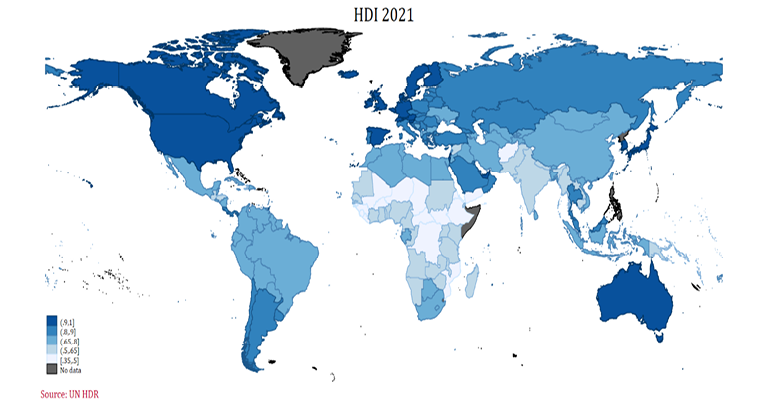
The slight majority of countries marked an improvement compared to 2020, overcoming the first year of the pandemic. Considerable variation is evident not only in GDP per capita, but also in average years of schooling (western economies exceed 12 years and sub-Saharan countries record less than five on average) and life expectancy (above 84 years in Australia, Japan, and Hong Kong and less than 55 in South Sudan, Central African Republic, and Lesotho). It is not worthy that some success stories in the front of economic growth are still lacking in providing their individuals the capabilities for development. Botswana and Equatorial Guinea are 43 and 47 positions lower in rank when one considers HDI compared to GDP per capita.
The latest Fragile States Index Report (FFP, 2022) underscores that fragility is not given despite the rebound in economic activity in the vast majority of economies during 2021. The report raises concerns for personal security and Human Security in general by highlighting the sharp deterioration in countries like Myanmar, Afghanistan and Lebanon and also the worsening in advanced economies like the United States and Greece (Figure 2). The somewhat surprisingly worsening performance of the United States in the 2009-2021 period was driven to a great extent due to indicators referred to as State Apparatus, Fractionalized Elites and Group Grievance. The latter is evident in the growing polarization of the US society and the events in the Capitol in January 2021.‡‡
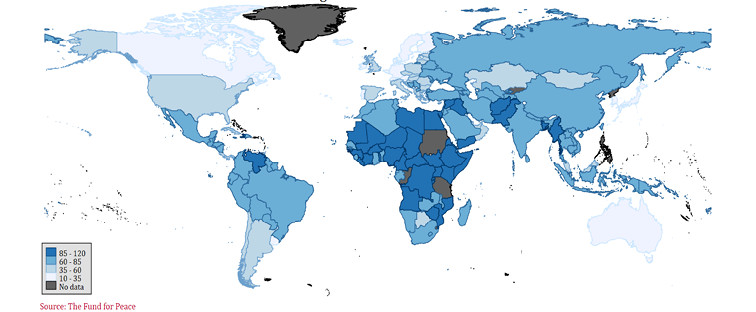
The global divergence in political security is perhaps best described by the cross-country deviation in the Corruption Perception Index. According to the 2021 data, the Nordic countries in Europe are on top of the list coupled with Singapore and New Zealand from the Asia Pacific region. There is only one entry from Sub Saharan Africa (Seychelles) and the Middle East and North Africa region (United Arab Emirates) among the top 25 performers, whereas only one member of the Eastern Europe and Central Asia region (Georgia) has a place in the first 50 countries in terms of tackling corruption. An issue to consider is not only the persistence of deviations across regions but also the steady or declining performance of laggard regions (Figure 3). In the 10 years between 2012 and 2021, SSA performance slightly deteriorated from a value of 33.4 to 32.5, whereas signs of improvement are starting to manifest in the ECA region. Finally, average regional performance can mask important variability as is the case for the Americas and Asia Pacific regions (Figure 4).
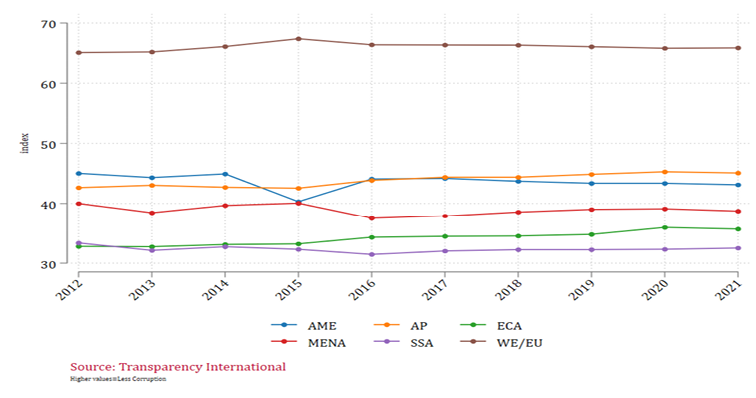
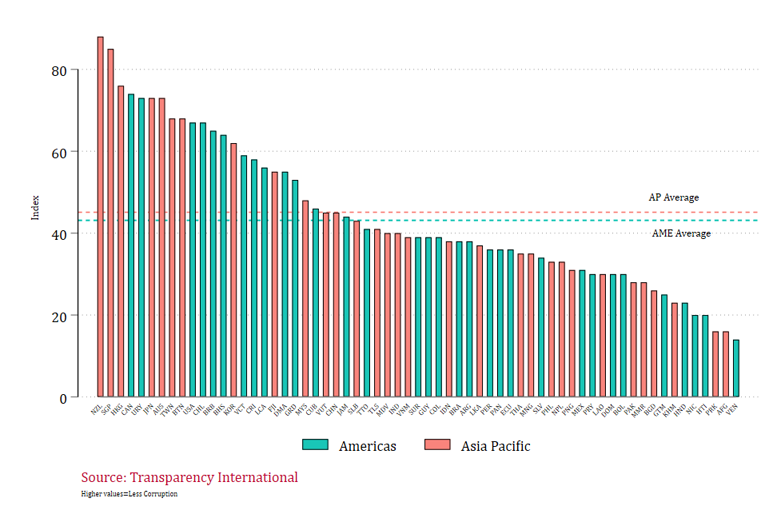
The World Health Organization provides a rich share of data on health security. Its healthy life expectancy (HALE) complements the life expectancy statistics reported (inter alia) in the HDR. Global life expectancy increased from 66.8 years in 2000 to 73.3 years in 2019, as did healthy life expectancy from 58.3 years to 63.7 years. As shown in Figure 5, global imbalances are ever present in the realm of healthy life expectancy underlining the threats to health security stemming from substantial inequalities in access to affordable health care, sanitation, and nutritional intake.§§ Food Security is intrinsically correlated with health security and patterns of risk across the globe are evident as can be seen in Figure 6. The Food Index component of the Ecological Threats Report (IEP, 2022) links the adverse impact of climate change with challenges for food security. The latest data indicate that the overwhelming majority of African countries faced substantial food insecurity in 2021 (a 4 or 5 score in the 5-digit scale).
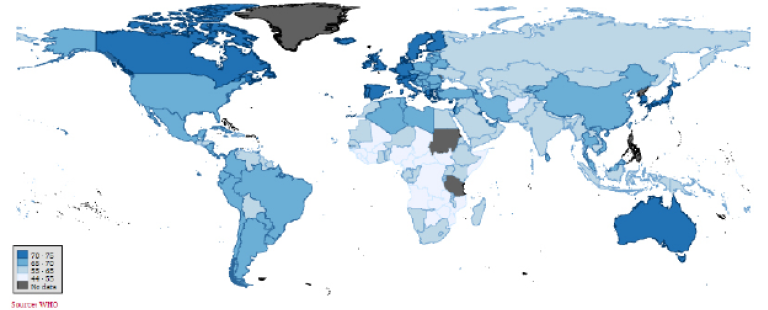
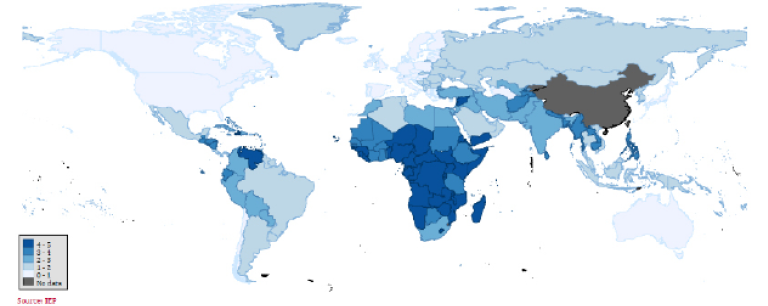
Environmental security is globally under attack and policy action has been underscored ever more in the COP meetings and enshrined in the Paris Agreement and the most recent developments of the European Green Deal and the Inflation Reduction Act in the USA.¶¶,***

"The advent of the SDGs has emboldened the importance of Human Security and human development rather than sidelining it."
The EPI report and the accompanying in-depth data set monitor key variables and indicators pertaining to climate risks, climate adaptation and mitigation, and climate policies. Given the salience of biodiversity for environmental and health security, the report includes a Biodiversity Habitat Index (Figure 7).
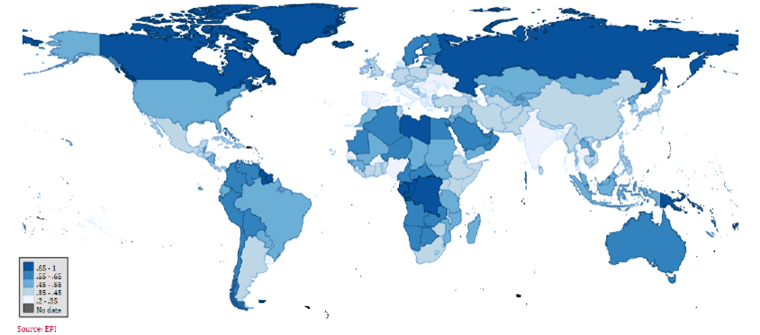
According to the latest data the record on biodiversity targets is mixed since 10% of the world’s coastline and marine areas have been preserved, exceeding the Aichi Biodiversity Target 11, whereas the target of preserving 17% of terrestrial areas by 2020 was not met, million square kilometers of protections.
Figure 8 indicates that high-performing Asian economies face substantial risk to Human Security through the combination of substantial biodiversity losses and elevated exposure to CO emissions (bottom-right panel).
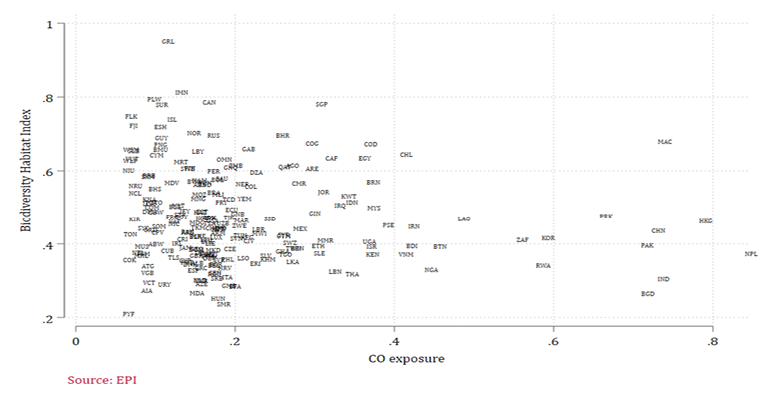
4. Human Security and SDG Implementation
As documented in the previous sections, the introduction, monitoring and implementation of the SDGs within the UN 2030 Agenda is inherently related to the concept of Human Security and its components (as defined by the 1994 HDR). Above all, the Agenda 2030 is the bedrock for development policies that enable individuals and societies to be safe from violent conflict, hunger, multidimensional poverty, hunger, disease, and oppression for any minority or group. According to the UN Trust Fund for Human Security “Human Security serves as both an analytical lens and a programming framework that complements and enriches mechanisms to attain the SDGs. Human Security initiatives engage closely with people to uncover their specific needs and vulnerabilities, and advance policies and actions based on their priorities, resulting in sustainable development gains across and within countries.”‡‡‡ Crabtree and Gasper (2020) argue that the advent of the SDGs has emboldened the importance of Human Security and human development rather than sidelining it, as critics have argued. The authors underscore the improvement of the SDGs concept over prior developmental accords (for example the HDI and the Millennium Development Goals) through the prevalence of interdisciplinary cooperation over fragmentation and policy silos. It comes as no surprise that Koehler et al. (2012) had highlighted the need for the MDGs to be enriched to encompass the concept of Human Security, something that was achieved, to a great extent, three years after their publication.
All the reports germane to Human Security and any of its components can be mapped against the 16 SDGs (leaving aside SDG 17—Partnerships to achieve the Goals).§§§ In many cases, the reports explicitly refer to the SDGs monitored by their content and presented indicators. We attempt to conceptually map some of the flagship reports on the specific SDGs they cover, based on the methodology and specific indicators used in the UN SDSN Sustainable Development Report.¶¶¶ Figure 9 proposes a conceptual mapping of the reports and resources for Human Security indicators to the 16 SDGs using self-calculated weights based on the salience of each goal in the respective report. For example, the HDR is associated (at least) with 5 goals, as it considers economic growth, educational attainment, and healthy life in the construction of the HDI. Given the multi-layered approach in the report, we also link it to SDG1 and SDG2, connecting human development to the goals of alleviating poverty and hunger. Following this primary, context-based approach we identify focused resources on Human Security, directly linked to a specific goal, such as the CPI associated with SDG16 and the GPI with SDG3. By contrast, the reports and data from the EPI offer a diverse set of concepts and indicators, which allows for the mapping of four distinct SDGs (Figure 9). The effect of the broader concept covered in some reports is depicted in the cases of both the Multidimensional Poverty Report and the Fragile States Index. It needs to be noted that the two linkages forged with the V-DEM node refer the institute’s Democracy Report, whereas the entirety of resources and indicators available in V-DEM can be associated to more than 5 SDGs.
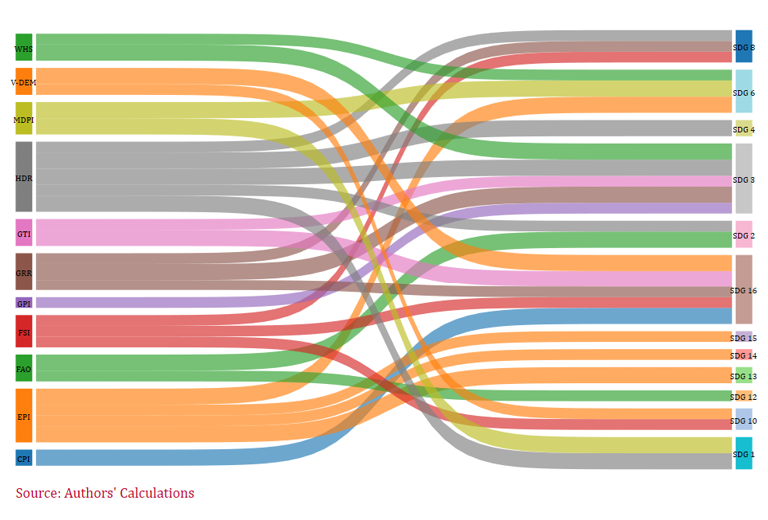
5. Concluding Remarks
Human Security is a multifaceted concept that encompasses the notions that matter for the well-being of individuals and the functioning of inclusive societies. Although there exists no single metric and this has been the main point of interdisciplinary critique, there is a battery of indicators, resources and publications that can help us assess the progress towards Human Security. This paper attempts to briefly describe some of them on the basis of relevance to the seven components of Human Security as defined by the United Nations Development Program (UN HDR, 1994). The information available to scholars and policymakers is in the form of hard data, composite indicators, reports, and projections and contributes to the balanced measurement of the progress and risks facing Human Security in a fashion which allows for cross-country comparisons and mapping of trajectories across time.
An important trait of the resources in Human Security is that they can be associated and linked with the Sustainable Development Goals and provide a useful tool in policy design towards transformation and sustainability. This paper introduces a preliminary approach to mapping the Human Security reports to specific SDGs using a conceptual methodology. Using advanced machine learning methods would allow us to form concrete linkages between individual data and indicators on Human Security to the seven classifications of Human Security and also to the 169 indicators underpinning the 17 SDGs.**** This can provide a comprehensive set of interdependencies and trade-offs for the design and implementation of the SDGs without neglecting the tenets of Human Security and is definitely a very promising field for future research.
Bibliography
- Charron, N., V. Lapuente, M. Bauhr & P. Annoni, “Change and Continuity in Quality of Government: Trends in subnational quality of government in EU member states.” Investigaciones Regionales-Journal of Regional Research, 53 (2022): 5-23.
- Commission on Human Security, Human Security now: protecting and empowering people. (United Nations New York, 2003)
- Crabtree, A., & Gasper, D. “Conclusion: The sustainable development goals and capability and Human Security analysis” in Sustainability, capabilities and Human Security (Palgrave Macmillan, Cham, 2020).
- Dahlberg, S., Sundström, A., Holmberg, S., Rothstein, B., Alvarado Pachon, N. & C. M. Dalli. The Quality of Government Basic Dataset, version Jan22. University of Gothenburg: The Quality of Government Institute (2022), derived from
https://papers.ssrn.com/sol3/papers.cfm?abstract_id=4087397 Davies, Shawn, Therese Pettersson & Magnus Öberg, “Organized violence 1989-2021 and drone warfare.” Journal of Peace Research no. 59 (2022). - Eurostat Living Conditions in Europe, 2018 Edition. (Eurostat, 2018)
- Human Security Centre, Human Security report 2005: War and Peace in the 21st Century (New York: Oxford University Press., 2005)
- Fukuda-Parr, S., & Messineo, C, “Human Security: A critical review of the literature.” Centre for Research on Peace and Development (CRPD) Working Paper, 11 (2012): 1-19.
- Gasper, Des, ‘Securing Humanity: Situating “Human Security” as Concept and Discourse’ Journal of Human Development 6:2 (2005): 221-245
- Granoff, J., “Approaching Human Security”, Cadmus vol 4:3 (2020)
- Institute for Economics & Peace, Global Peace Index 2022: Measuring Peace in a Complex World, (Sydney, 2022).
- Institute for Economics & Peace, Ecological Threat Report 2022 (IEP Sydney, June 2022)
- Available from: http://visionofhumanity.org/resources (accessed December 2, 2022).
- Kaufmann, D., Kraay, A. and Mastruzzi, M., “The Worldwide Governance Indicators: Methodology and Analytical Issues”, World Bank Policy Research Working Paper No. 5430 (2010), Available at SSRN: https://ssrn.com/abstract=1682130.
- Köhler, G., Gasper, D., Jolly, R., & Simane, M., “Human Security and the Next Generation of Comprehensive Development Goals”, Journal of Human Security Studies, 1: 2 (2012): 75–79.
- Koundouri, P., Devves, S., & Plataniotis, A., “Alignment of the European Green Deal, the Sustainable Development Goals and the European Semester Process: Method and Application”. Theoretical Economics Letters, 11 (2021): 743-770.
- MacFarlane, S.N and Y. F. Khong, Human Security and the UN; A Critical History (Indiana University Press, 2006)
- OECD, How’s Life? 2020: Measuring Well-being (OECD Publishing, Paris, 2020) https://doi.org/10.1787/9870c393-en.
- OECD, Society at a Glance 2019: OECD Social Indicators, (OECD Publishing, Paris, 2019) https://doi.org/10.1787/soc_glance-2019-en.
- Paris, Roland, ‘Human Security: Paradigm Shift or Hot Air?’ International Security 26.2 (2001): 87-102
- SIPRI, SIPRI Yearbook 2019 – summary (SIPRI, 2019) https://www.sipri.org/sites/default/files/2019-08/yb19_summary_eng_1.pdf
- The Fund for Peace, The Fragile States Index Annual Report (FFP, 2022)
- Albrecht, U. et al., A Human Security Doctrine for Europe: the Barcelona Report (Study Group on Europe’s Security Capabilities, 2004) https://www.consilium.europa.eu/uedocs/cms_data/docs/pressdata/solana/040915CapBar.pdf
- Transparency International, Corruption Perceptions Index 2018 (Transparency International, 2019) https://www.transparency.org/files/content/pages/2018_CPI_Executive_Summary.pdf
- UNDP, Human Development Report 1994 (New York and Oxford: Oxford University Press, 1994)
- UNDP, Human Development Report 1999 (New York and Oxford: Oxford University Press, 1999) https://hdr.undp.org/system/files/documents/hdr1999ennostatspdf.pdf
- UNDP, Human Development Report 2021/22. (New York and Oxford: Oxford University Press, 2022)
- UNDP, New threats to Human Security in the Anthropocene: Demanding greater solidarity – Special Report (New York and Oxford: Oxford University Press, 2022)
- UNDP and Oxford Poverty Human Development Initiative, Global Multidimensional Poverty Index: Unpacking deprivation bundles to reduce multidimensional poverty (United Nations Development Program and Oxford Poverty and Human Development Initiative, 2022)
- UN Trust Fund for Human Security, Human Security and Agenda 2030 (United Nations, 2022) Available at https://www.un.org/humansecurity/wp-content/uploads/2017/10/Human-Security-and-the-SDGs.pdf
- Wolf, M. J, Emerson, J. W., Esty, D. C., de Sherbinin, A., Wendling, Z. A., et al. 2022 Environmental Performance Index (Yale Center for Environmental Law & Policy. epi.yale.edu, 2022)
- Varieties of Democracy Institute, Democracy Report 2022: Autocratization Changing Nature? (University of Gothenburg, 2022)
- World Economic Forum The global risks report 2019 (WEF, 2019). www.weforum.org/reports/the-global-risks-report-2019
- World Economic Forum, The global risks report 2022 (WEF, 2022).
- World Health Organization, World Health Statistics: measuring Health for SDGs (WHO, 2018)
- World Health Organization, World Health Statistics: measuring Health for SDGs (WHO, 2022)
Appendix
Table 1: Sustainable Development Goals
|
SDG 1 |
No Poverty |
|
SDG 2 |
Zero Hunger |
|
SDG 3 |
Good Health and Well-being |
|
SDG 4 |
Quality Education |
|
SDG 5 |
Gender Equality |
|
SDG 6 |
Clean Water and Sanitation |
|
SDG 7 |
Affordable and Clean Energy |
|
SDG 8 |
Decent Work and Economic Growth |
|
SDG 9 |
Industry, Innovation, and Infrastructure |
|
SDG 10 |
Reduced Inequality |
|
SDG 11 |
Sustainable Cities and Communities |
|
SDG 12 |
Responsible Consumption and Production |
|
SDG 13 |
Climate Action |
|
SDG 14 |
Life Below Water |
|
SDG 15 |
Life on Land |
|
SDG 16 |
Peace, Justice and Strong Institutions |
|
SDG 17 |
Partnerships to achieve the Goals |
* Kofi Annan. “Secretary-General Salutes International Workshop on Human Security in Mongolia.” Two-Day Session in Ulaanbaatar, May 8-10, 2000. Press Release SG/SM/7382. https://press.un.org/en/2000/20000508.sgsm7382.doc.html 08/27/01
† A prominent example of this literature is Paris (2001) ‘Human Security: Paradigm Shift or Hot Air?’
‡ The health dimension is assessed by life expectancy at birth, the education dimension is measured by mean of years of schooling for adults aged 25 years and more and expected years of schooling for children of school entering age. The standard of living dimension is measured by gross national income per capita.
§ The indicator is compiled by the World Values Survey and consists of three dimensions, namely fear of violent conflict, socioeconomic insecurity, and personal and community insecurity, covering a total of 17 variables.
¶ Health dimension accounts for nutrition and child mortality, the education dimension includes years of schooling and school attendance, and the standard of living dimension includes data on cooking fuels, sanitation, drinking water, electricity, housing, and financial assets.
** Comparable estimates are achieved by adjusting or modelling country data to allow comparisons across countries and over time (WHO, 2022).
†† National net zero targets vary with regards to the target year; what emissions and economic sectors are covered; whether the country intends to use reductions or removals outside its own borders; the role of carbon dioxide removals; whether the net zero target consists of two separate reduction and removal targets; governance and planning processes; and fairness considerations (CAT, 2022).
‡‡ The Fragile States Index is composed by 12 sub-indicators, divided in 5 categories. Category C includes the three dimensions discussed in this section.
§§ The share of healthy life expectance over life expectancy in total is to a large extent concentrated around 85%.
*** Here’s what’s in the Inflation Reduction Act, the sweeping health and climate bill passed Sunday | The Hill
††† Higher values indicate greater preservation of Biodiversity.
§§§ See Appendix Table 1 for a complete list of the SDGs.
¶¶¶ All reported indicators can be accessed at https://dashboards.sdgindex.org/explorer.
**** For a description of the proposed methodology see Koundouri et al. (2021).



